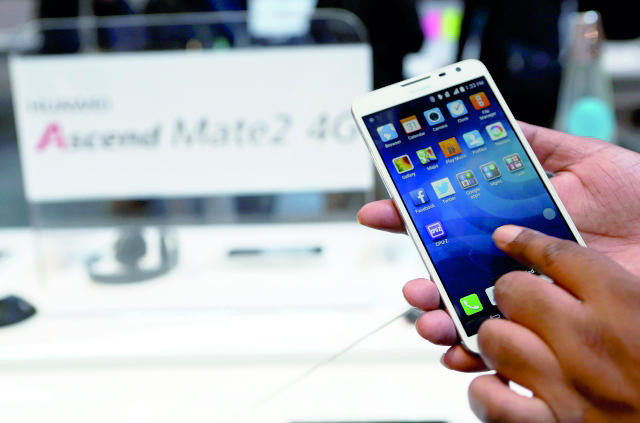BEIJING: China’s Huawei Technologies Co. Ltd, known more for its telecom networking prowess than its razor-thin smartphones, is starting to see success in its consumer electronics business, though the key US market remains elusive.
Huawei became the world’s third-biggest smartphone manufacturer last year, mainly due to a fast-growing Chinese market. That is helping cushion the impact of a global slowdown in network equipment spending, which caused the company to miss its revenue growth target last year.
Consumer devices will also help Huawei buy some time before 4G network upgrades in China lead to more orders for telecom equipment.
Huawei’s smartphone ventures, like its domestic rivals ZTE Corp. and Lenovo Group Ltd, have so far focused on selling low- and mid-priced handsets in emerging markets.
The companies have yet to gain a foothold in the high-end segment of developed markets — such as the US — that offer wider margins.
Huawei’s name is virtually unknown — and unpronounceable — in the US, the second-biggest smartphone market, where lawmakers have flagged Chinese telecommunications equipment as potential security risks.
“Huawei in an ideal world would love to be in the US but it’s probably better for them to be seen as eyeing up the market than be seen as begging,” said Duncan Clark, chairman of Beijing-based tech advisory BDA.
“They can probably succeed in the US in this world of consumer electronics, where consumers, not carriers, can choose what to buy.”
Consumer devices accounted for 23 percent of Huawei’s overall revenue last year, up from 22 percent in 2012. That helped lift total unaudited revenue to 238 billion yuan to 240 billion yuan ($39.73 billion), Chief Financial Officer Cathy Meng told a press briefing on Wednesday.
Unaudited revenue grew 8 percent, compared with a target of 10 percent annual growth for the next five years, starting in 2013.
Unaudited operating profit rose to 28.6 billion yuan to 29.4 billion yuan, the company said. That compared with an audited 2012 operating profit of 19.96 billion yuan — an increase of 43.3 percent.
The company put the leap in operating profit down to changes in internal management and reducing operating costs.
Huawei will release audited results in March or April, including net profit which should not be largely different from operating profit, the company said.
Huawei had a 5.1 percent share of the global smartphone market in October-December, a distant third behind Samsung Electronics Co. Ltd. with 35.2 percent and Apple Inc. with 13.4 percent, according to Strategy Analytics.
“Huawei had some ambivalence to smartphones, at one point thinking of selling off the unit, but they made a conscious decision to embrace it,” said BDA’s Clark.
“It’s been a lower-margin business than other areas but the end-to-end vision, it’s going to be part of the future.”
Huawei aspires to challenge Samsung and Apple and in the United States but it has virtually no brand recognition there beyond its association with espionage, and has only a smattering of low-key tie-ups with US carriers through which most consumers buy their phones.
The Shenzhen-based maker has sought to change that by splashing out on a prime location at this year’s Consumer Electronics Show in Las Vegas.
It has no such issues in its home market which contributed around 50 percent of growth last year in its consumer devices business, a company spokesman said.
Sales are also strong in Europe, according to the company, where the European Commission is poised to launch an investigation into anti-competitive behavior by Chinese producers of telecoms equipment. (Full Story)
Its consumer electronics business grew 13.2 percent year-on-year based on Reuters calculations.
“The handset business is quite profitable and operating above expectations,” said Huang Leping, a Hong Kong-based technology analyst with Nomura.
Huawei targeted smartphone shipments of 60 million units last year. The company said actual shipments reached 52 million units, which Huang called “quite a good result.”
Huawei is the world’s second-biggest telecom equipment maker after Sweden’s Ericsson, and is known for aggressively gaining sales by edging out rivals such as Cisco Systems Inc. CSCO.O, Alcatel-Lucent, Nokia Siemens Networks.
Its carrier network business booked 70 percent of unaudited revenue for 2013 but only grew 4.1 percent according to Reuters calculations, despite China and a slew of other countries contracting Huawei to help build fourth-generation mobile networks.
The company has also suffered by being excluded from building networks in the US and Australia because of fears it is linked to the Chinese government — allegations it denies. The company has come under scrutiny in Britain over cyber security issues. (Full Story) (Full Story)
The carrier business group’s growth rate “was not as pretty as the two other groups, but the base number is very big,” Chief Financial Officer Cathy Meng told a press briefing.
But analysts say 4G deployment in China hasn’t been as fast as expected, so revenue from the network roll-out destined for Huawei and cross-town competitor ZTE will not be seen until the first half of this year.
“For 4G, they have a delay on revenue in China,” said Nomura’s Huang.
“Deployment was slower than expected, so there is revenue postponed until the first half of this year, particularly some short-term delays on China Mobile’s deployment speed.”
The rest of Huawei’s revenue, or 7 percent, comes from its enterprise segment, which makes telecommunications devices for businesses and institutions, and which is not profitable, according to Meng.
Addressing the company’s woes over cyber-security issues in the US and elsewhere, Meng said it is “all decided by the market.”
“We have seen no incidents on networks due to security problems,” Meng said. “A lot of reports say Huawei equipment has more vulnerabilities or is more easily breached. These reports are groundless.”
Huawei profit jumps on smartphones
Huawei profit jumps on smartphones










